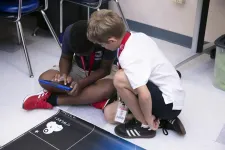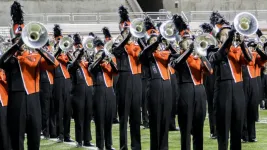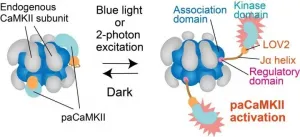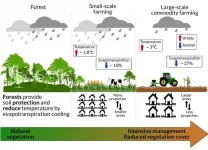(Press-News.org) The world is changing rapidly and in order to serve the human population dealing with those changes, American universities need to change, too. In fact, their role is to model the resiliency that all institutions need to embrace, according to Arizona State University President Michael M. Crow.
While many leading universities are poised to advance society and help respond to the challenges of disruptive change through their traditional role in education and discovery, many face a number of barriers that make them less prepared to respond to the rapidly changing conditions and the demands they create.
What is emerging is a new type of university, one that steps beyond the American research university model and is nimble and responsive, takes responsibility for what happens outside its walls and can scale up to meet the demands and challenges of modern society. ASU President Michael Crow says they are part of the "fifth wave" of universities.
Crow's comments came today (Feb. 9, 2021) at the annual meeting of the American Association for the Advancement of Science. Crow's presentation, "A new evolution of research universities," touched on the history of universities, outlined the challenges they face today and explained how new universities of the fifth wave will rise to meet those challenges.
In his recent book "The Fifth Wave," (written with ASU senior research fellow William Dabars) Crow describes the emerging standard of research universities that will better align them with the needs of society in many ways, including contributing solutions to global problems.
The fifth wave is a manifestation of a new wave of American universities, a model embraced and advanced by Arizona State University. These universities are egalitarian, accessible, based in community impact and measured against social outcomes. They are scalable, they are technologically sophisticated and advanced. They educate not hundreds of students, but thousands and tens of thousands of students, Crow said.
Many of today's leading universities are American research universities, which emerged nearly 140 years ago - the fourth wave of university evolution. These universities have a long history of contributions to society, such as breakthrough advances in the fundamental understanding of nature, advancing applied science on a multitude of fronts, and advancing human culture, human's sense of place and sense of self.
"This has all has been fantastic, but inadequate," Crow said. "Because what happened during the evolution of the research university is that it has become more exclusive, more limited to smaller and smaller fragments of society, and more and more isolated from larger aspects of society itself."
The COVID-19 pandemic is a case in point on the limits of the traditional research university.
"America's universities were about as unprepared for this pandemic as one could possibly imagine," Crow said. "Suddenly, we didn't know how to communicate science well enough, we didn't know how to engage in complexity well enough, we didn't know how to cut and cross between disciplines well enough, and we didn't know how to build confidence around knowledge well enough."
The pandemic shows that what is needed is an additional type of university, not a replacement for the ones that exist and are exemplars today, but an additional type of higher educational institutions. "The fifth wave will allow us to do it," Crow said.
The "new" universities are responsive to the rapidly evolving needs of society. Their hallmarks include being inclusive in their educational philosophy and understanding that all people are lifelong learners; contributing to the challenges humans face today on a grand scale, like climate change and the current pandemic; taking stock in their immediate surroundings and being responsible for the success of that setting and of society as a whole.
"We are faced with an evolutionary moment. The role of the university, its role in discovery, its role in creativity, its role in innovation has never been more important and also its limits have never been clearer," Crow said. "The significant role going forward is figuring out the role of existing research universities and the role of emerging universities, including those that need to operate at a new scale, a new speed and a new egalitarianism."
Crow warned, though, that certain barriers exist that can thwart the evolution of fifth wave universities.
"We form athletic leagues, but we don't form climate change research leagues," he said. "The current model is to have faculty largely work in small centers and small groups, each attempting to advance their fields in a highly competitive way to beat out their competitors. This leaves little room for working on the scaled problems, like how do we manage our relationship with the planet, how will we facilitate cultural and economic competitiveness and do so to the benefit of a highly diverse population. How do we map between Western science, Western culture, Western technology and Indigenous science, Indigenous culture and Indigenous technology?"
Crow explained that in shaping the New American University model is the idea that the university will take responsibility for actions outside of the institution itself.
"If K-12 is underperforming, the institution is partly responsible," Crow said. "If 50% of students graduating from high school are inadequately prepared for the society in which we live, the universities and colleges are partly responsible."
Once the institution takes on that responsibility outside of its walls, then its contribution to society becomes real in a daily way.
"Then we will have the emergence of a new type of American research university, one which is devoted to the actual measured success of the society in which it is embedded," Crow added. "Not in an abstract intergenerational way but in a functional way. In a day-to-day way."
INFORMATION:
Not all friendships are created equal. Some friends get along; others struggle to avoid conflict. Conventional wisdom holds that the tenor of a friendship with someone who is nice differs from that with someone who is mean, such that the former discourages negative interactions whereas the latter aggravates them. Although it is logical to assume that children who are mean have friendships characterized by growing strife and that children who are nice report little of the same, these assumptions have not yet been tested in the real-world friendships of children.
Researchers from Florida Atlantic University's Charles E. Schmidt College of Science are the first to conduct a longitudinal study to examine the extent to which being "nice" (prosocial behavior) and being "mean" (relationally aggressive ...
A new study from University of Alberta researchers has shown that traumatic or stressful events in childhood may lead to tiny changes in key brain structures that can now be identified decades later.
The study is the first to show that trauma or maltreatment during a child's early years--a well-known risk factor for developing mental health conditions such as major depressive disorder in adulthood--triggers changes in specific subregions of the amygdala and the hippocampus.
Once these changes occur, researchers believe the affected regions of the brain may not function as well, potentially increasing the risk of developing mental health disorders as adults during times of stress.
"Now ...
CORVALLIS, Ore. - Marching band members in leadership roles are more likely to feel discomfort in the neck and upper back than their less experienced bandmates, who in turn are more susceptible to left-hand pain and cognitive strain, a new study by Oregon State University suggests.
The findings also showed that gender had no bearing on how much discomfort a musician felt or the band member's perception of workload.
"The study really seems to indicate that a player's level of experience and role within the band are what drive how much discomfort they feel," said industrial ...
Neurons are the primary cells of the nervous system, and the signals that are transmitted between them are responsible for all our actions and our cognitive ability. In particular, learning and memory are believed to be associated with a process called "long-term potentiation," which is the strengthening of connections between specific neurons via continued signal transmission through "synapses" (small gaps between neurons). Long-term potentiation can change the connection between neurons via synapses--by changing their size and composition. Understanding ...
Researchers report that large-scale commercial farms on deforested land in the southern Amazon result in higher temperature increases and less rainfall than small-scale farms.
Deforestation has converted swaths of land in the southern Amazon region from rainforest to farmland. The uses of the deforested land are diverse, and activities can range from small-scale farming in rural settlements to large-scale commodity agriculture. Commercial farms in the Southern Amazon can reach hundreds of thousands of hectares in area, exporting millions of tons in grains and beef every year.
Eduardo Maeda from the University of Helsinki and colleagues used satellite data to compare areas dominated by different land uses and farm sizes to evaluate their impacts on ...
Li-ion batteries (LIBs) are widely used in various mobile electronics. Concerns of global warming and climate change have recently boosted the demand for LIBs in electric vehicles and solar photovoltaic output smoothing. Si has been studied as an active material with a high theoretical capacity of 3578 mAh/g, which is around ten times higher than that of graphite (372 mAh/g).
Now, a team of researchers at Osaka University has used flake-shaped Si nanopowder wrapped by ultrathin graphite sheets (GSs) to fabricate LIB electrodes with high areal capacity and current density.
Generally ...
Rivers and lakes at high latitudes are considered to be major sources for greenhouse gas emissions to the atmosphere, but these losses are poorly constrained. In a study published in Nature Communications, Umeå University researchers and collaborators quantify carbon emissions from rivers and lakes across Western Siberia, finding that emission are high and exceed carbon export to the Arctic Ocean.
High latitude regions play a key role in the global carbon cycle and climate system. An important question is the degree of mobilization and atmospheric release of vast soil carbon stocks, partly stored in permafrost, with amplified warming of these regions. A fraction of this carbon is exported to inland waters and emitted to the atmosphere, yet these ...
Cryopreservation involves preserving biological materials, such as cells, tissues, and organs, at ultra-low temperatures so that they can be revived and used at a later date. To achieve cryopreservation such that the preserved materials are not damaged, scientists use various chemicals called cryoprotectants, which facilitate the freezing process. Unfortunately, many of the existing cryoprotective agents have major limitations. For example, dimethyl sulfoxide is useful for cryopreserving red blood cells, but it is also toxic to the cells.
To overcome these limitations, researchers at the Japan Advanced Institute of Science and Technology (JAIST) and Japan's RIKEN have experimented with a class of chemicals known as polyampholytes, identifying one ...
In research on solar energy and climatology, "clear sky" or "cloudless" conditions are very important. For instance, the number of clear-sky days (number of days having an average cloud cover less than 10%) is a key parameter of solar resource assessments. The instantaneous surface irradiance is highly affected by cloud variations, based on which clear-sky detection (CSD) methods can be developed. However, a general tendency in common among all CSD methods is the detection accuracy deteriorates when aerosol loading increases.
"The lack of accurate clear-sky detection data makes it difficult to assess existing clear-sky detection methods in polluted areas," explains Liu Mengqi, a PhD student from the group of Prof. Xiang'ao Xia at the Institute of Atmospheric Physics, Chinese ...
Researchers at the Garvan Institute of Medical Research have developed a computational model to calculate 'skeletal age', a personalised estimate of an individual's risk of bone fracture and premature death.
The skeletal age calculator, which will be accessible to doctors and health professionals, aims to better identify those at risk of a first bone fracture and subsequent fractures, and also estimates how fractures impact life expectancy.
Osteoporosis, a disease which reduces bone strength and increases bone fracture risk, is a major national health issue and estimated to affect over 900,000 Australians. ...






